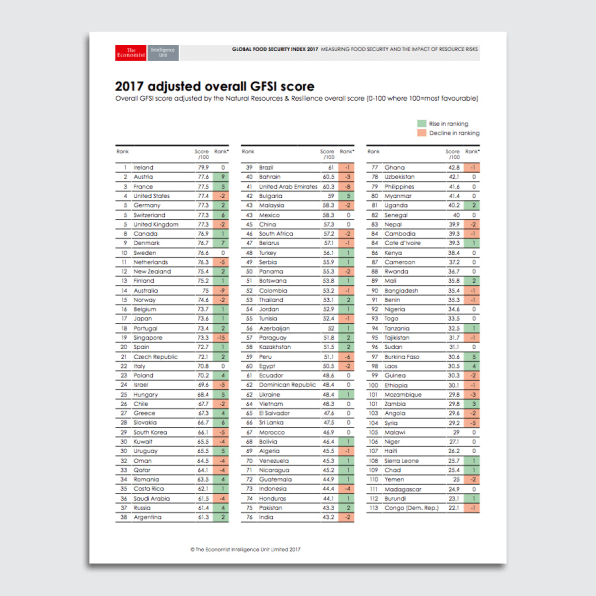How Climate Change Is Making Hunger Worse Around The World
Since 2012, the Economist Intelligence Unit, the research arm of the Economist group, has compiled a yearly assessment of the ability of 113 countries to feed their populations. This year, the Global Food Security Index recorded a slip in food security for the first time after four consecutive years of improvement; this trend is backed up by the United Nations Food and Agriculture Organization, which found that wars and climate-related disasters have left 38 million more people undernourished than in 2015.
The GFSI, which has been sponsored by DuPont since its inception, gets more granular, tracking the affordability, availability, quality, and safety of food on a country-by-country basis to come up with a comprehensive food security score. Around 60% of the 113 countries included in the GFSI saw their scores drop this year. For the first time, the U.S. dropped from its place at the top of the rankings, scoring 84.6 out of 100–a whole point less than Ireland, whose comeback after its financial crisis of 2008 has involved significant research and investment in supporting food security.

Ireland’s leap to the top was the result of concerted effort on the part of its government; some countries’ declines in food security are also attributable to austerity measures and inefficient resource management at the national level. But many of the countries’ tumbles are attributable to larger factors: earthquakes, fires, floods, national unrest. “These not only have a huge impact on people’s lives–they also have a destructive effect on tracks of agriculture and farming land,” says EIU senior consultant Robert Powell at an event during the United Nations General Assembly in New York. “And what’s the outcome of that? It means that there’s more mouths to feed, but there’s less land with which to feed them.”
So this year, to capture the effect of climate change on a country’s overall food security, the GFSI report has added a new Natural Resource and Resilience (or Exposure) indicator. The Exposure indicator is separate from the baseline indicators, to allow for easier comparisons with previous years’ data sets, but can be overlaid on the baseline GFSI scores to create an adjusted score. “What this indicator does is it adds a stronger forecasting element to the data,” Powell tells Fast Company. The baseline indicators, he adds, provide a snapshot of food security in a country as it currently stands, but the Exposure indicator quantifies the challenges ahead, that are contingent on how a country responds to the volatility produced by climate change.
With the Exposure adjustment, Ireland remains at the top, but the U.S. drops down to fourth place from second, knocked back by Austria and France, whose Natural Resource and Resilience scores of 80.3 and 76.5, respectively, cast the U.S.’ score of 65.8 in a shameful light.
Broadly speaking, the Exposure indicator measures two things: how susceptible national economies are to climate-related risks, and how well-equipped they are to mitigate and adapt to those risks. It’s further broken down by six sub-indicators: temperature rise, drought, flooding, storm severity, sea level rise, and commitment to managing exposure. There are bright spots and causes for concern scattered fairly evenly across the 113 countries in the GFSI. Denmark, for example, was the first country to create a ministry dedicated to environmental issues, and the country’s resilient design and steady GDP, coupled with an impressive management of freshwater resources (only 7.8% of drinkable water is lost before it reaches consumers, as opposed to the 30% to 60% seen in other countries), lands it at the top of the Natural Resources and Resilience rankings. Singapore, in contrast, is an example of how “certain accidents in geography” can damage resilience, Powell says. The tiny country has a strong GDP, but its susceptibility to severe storms and reliance on imported food resources; it’s tied with Oman for 106th in the Natural Resources and Resilience rankings, a sharp drop from it’s number-four spot in the baseline rankings.
The challenges for developed and developing countries in building resilience differ radically: For places like the U.S. and much of the European Union, the primary concern is fresh water availability, as urbanization and large-scale agriculture has contaminated over half of the water supply. The localized droughts in countries like Zambia and India, in contrast, shows the extent to which developing countries are vulnerable to changes in weather patterns, and highlight the need for governments, NGOs, and private companies to work in concert to build out stronger irrigation and monitoring systems, Powell says.
But really, what the new Exposure indicator shows “is that everybody loses,” Powell says. The highest score for countries in the baseline indicator rankings is 85.6; when those scores are adjusted to factor in natural resources and resiliency, the highest score is 79.9. All countries, no matter how the new category shuffles them in the rankings, see a decline in their scores when future concerns are factored in. “Climate change leaves nobody safe,” Powell says, “and every country, to a lesser or greater extent, will have to adapt.”
Fast Company , Read Full Story
(41)














